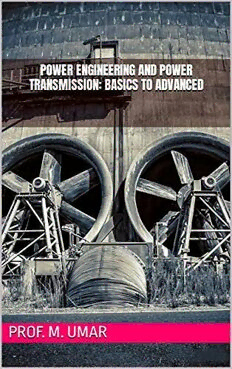
Power Engineering And Power Transmission: Basics To Advanced PDF
014.509 MB·English
Most books are stored in the elastic cloud where traffic is expensive. For this reason, we have a limit on daily download.
Preview Power Engineering And Power Transmission: Basics To Advanced
Description:
Power engineering and power transmission has been designed for the students of B.E./B.Tech Mechanical Engineering. Divided in two units it will also prove to be a valuable source for practicing engineers and teachers. It provides all the necessary information about power plants and steam power plant, nuclear and hydel power plants, diesel and gas turbine power plants, Geothermal plants, ocean thermal plants, tidal power plants, solar power plants and economics of various power plants.This hallmark text on Power Engineering provides the readers a comprehensive account of all key concepts in the field. The book includes latest technology developments and talks about some crucial areas of Power system, such as Transmission & Distribution, Analysis & Stability, and Protection & Switchgear. With all these features, this book is an indispensable text for electrical engineering students. Candidates preparing for various competitive exams, such as AMIE, GATE, IES and IAS, etc., as well as practicing engineers would also find this book extremely valuable as a text/reference book.Highlights:1. Complete syllabus coverage along with new trends and technologies2. Covers latest updates on current and future Indian Power Scenario3. New chapters on ◆Power System Security ◆Substations ◆Power Quality ◆State Estimation in Power System ◆Compensation in Power System ◆Renewable Energy and Smart Grid ◆Power System Economics and Management4. New appendices on ◆Power Electronic Systems ◆Synchrophasor Technology5. Rich pool of solved examples, theoretical and numerical problems, and MCQs with each chapterSalient features:-• Power engineering• What is Power Engineering – The Core of Electrical Engineering• Power Systems Engineering• What is a Power Engineer?• Transformer connections you are not allowed to forget• Doubts in ground testing that make electrical engineers pretty confused• What is the difference between a two-point, three-point, and four-point test?• How do I go about designing a good ground?• Does it matter how deep I drive the probes?• What safety precautions should I observe when performing a ground test?• FCC move modernizing 900 MHz opens door for safer, deeper utility commmunication networks• Company floats new proposal for hydropower on tribal land• Louisiana regulators OK SWEPCO part in Oklahoma wind projects• Golden Pass LNG export terminal to feature Siemens compressors, motors• Wärtsilä’s gas engine technology to advance Spanish CHP market• Southern-managed National Carbon Capture Center adding gas-fired CCUS R&D focus• Framatome providing in-house services for 15 reactors at eight EDF nuclear plants in U.K.• Alliant Energy closing Edgewater coal-fired plant, adding six solar projects in Wisconsin• Russia commissions world’s first floating nuclear plant• Fundamentals of Power System Protection• Zones and types of Protection system• Wireless Network Energy Management Systems• Understanding Smith Charts• The Basics of Battery Technology• The Mathematics of Resistance• How Dry Cell Batteries Generate Electricity• Explosion at Iranshahr• Very Large Battery Systems for Utility-Level Power Storage• Roles of Solar Power Regulators, Inverters, and Converters• 1961 -; England and France Share Power Grid• High Voltage DC Power vs AC Power Transmission• Overview of Nuclear Electrical Engineering• How Electricity is Generated• What Are Load Curves?• Power Loss Calculations In Electric Supply• Transformers : Transfer (as if) by Magic (Part II)• Principle of Conservation of Energy in Electrical Engineering – Kirchhoff’s Laws• Electricity at Rest – Electrostatic• The Basic Force behind Electricity – Potential Differences
See more
The list of books you might like
Most books are stored in the elastic cloud where traffic is expensive. For this reason, we have a limit on daily download.
